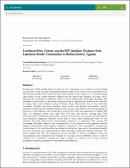| dc.contributor.author | Kwiringira, Japheth Nkiriyehe | |
| dc.contributor.author | Ariho, Paulino | |
| dc.contributor.author | Zakumumpa, Henry | |
| dc.contributor.author | Mugisha, James | |
| dc.contributor.author | Rujumba, Joseph | |
| dc.contributor.author | Mugisha, Marion Mutabazi | |
| dc.date.accessioned | 2022-01-28T09:43:44Z | |
| dc.date.available | 2022-01-28T09:43:44Z | |
| dc.date.issued | 2019 | |
| dc.identifier.citation | Kwiringira, Japheth N... et al (2019). Livelihood risk, culture, and the HIV interface: evidence from lakeshore border communities in Buliisa district, Uganda. Journal of Tropical Medicine. https://doi.org/10.1155/2019/6496240. | en_US |
| dc.identifier.uri | https://doi.org/10.1155/2019/6496240 | |
| dc.identifier.uri | https://kyuspace.kyu.ac.ug/xmlui/handle/20.500.12504/325 | |
| dc.description | 10 p. | en_US |
| dc.description.abstract | While studies have focused on HIV prevalence and incidence among fishing communities, there has been inadequate attention paid to the construction and perception of HIV risk among fisher folk. There has been limited research with respect to communities along Lake Albert on the border between Uganda and the Democratic Republic of Congo (DRC). Methods. We conducted a qualitative study on three landing sites of Butiaba, Bugoigo, and Wanseko on the shores of Lake Albert along the border of Uganda and the Democratic Republic of Congo. Data were collected using 12 Focus Group Discussions and 15 key informant interviews. Analysis was done manually using content and thematic approaches. Results. Lakeshore livelihoods split families between men, women, and children with varying degrees of exposure to HIV infection risk. Sustaining a thriving fish trade was dependent on taking high risks. For instance, profits were high when the lake was stormy. Landing sites were characterized by widespread prostitution, alcohol consumption, drug abuse, and child labour. Such behaviors negatively affected minors and in many ways predisposed them to HIV infection. The lake shore-border heterogeneity resulted in a population with varying HIV knowledge, attitudes, behavior, and competencies to risk perception and adaptation amidst negative masculinities and negative resilience. Conclusion. The susceptibility of lakeshore communities to HIV is attributable to a complex combination of geo-socio, the available (health) services, economic, and cultural factors which converged around the fishing livelihood. This study reveals that HIV risk assessment is an interplay of plural rationalities within the circumstances and constraints that impinge on the daily lives by different actors. A lack of cohesion in a multiethnic setting with large numbers of outsiders and a large transient population made the available HIV interventions less effective. | en_US |
| dc.language.iso | en | en_US |
| dc.publisher | Journal of Tropical Medicine. | en_US |
| dc.subject | Culture | en_US |
| dc.subject | HIV | en_US |
| dc.subject | Community | en_US |
| dc.subject | Buliisa | en_US |
| dc.subject | Uganda | en_US |
| dc.title | Livelihood risk, culture, and the HIV interface: evidence from lakeshore border communities in Buliisa district, Uganda | en_US |
| dc.type | Article | en_US |

